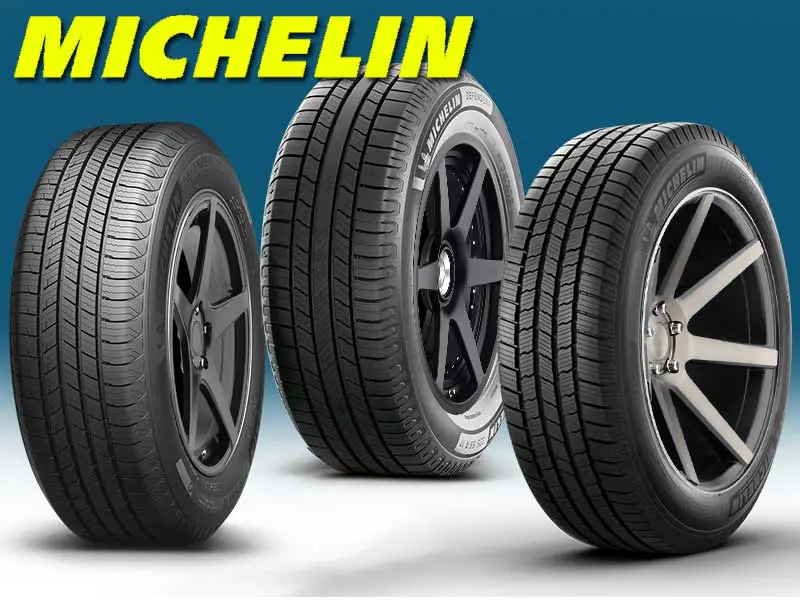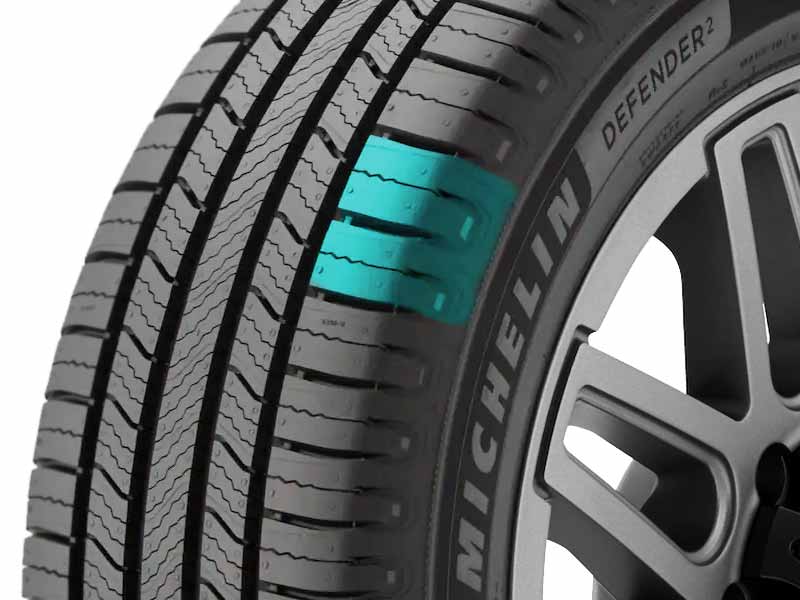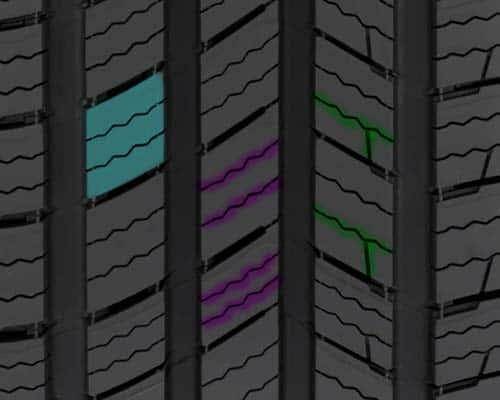All these tires from Michelin Defender’s family, the Defender T+H, the famous Defender LTX MS and the latest updated variant, the Defender 2 are premium all season tires which are built to last.
The Michelin Defender 2 gives you amazing tread life and on-road (dry) traction. While the T+H offers superior wet grip and comfort along with winter traction. The Defender LTX M/S on the other hand, offers towing abilities and greater off-road traction, while still keeping things great on pavements.

Table of Contents
Design Differences
Starting with Michelin Defender 2, the tire features a continuous rib in the middle (which I marked with red color). With this tire’s tries to make maximum contact with the road and provides enhanced dry grip.

But with numerous sipes, with dry grip, the wet grip is also not compromised at all, as all these sipes are full depth and 3D, providing a very satisfactory wet road stability.
The 4 (equally wide), longitudinal channels also aid wet road traction, by providing hydroplaning resistance.
These channels are connected to each other with lateral (wave like) grooves, forming blocks, which are also connected to each other with tie bars, if you can find them.
On the shoulder blocks, the Michelin Defender 2 shows up with a very minimal design with less number of sipes and J shaped grooves on the outer edges.

With the connectors between the shoulder blocks, the tread provides ample lateral traction.
If you look at Michelin Defender T+H, which is the previous version of Defender 2, the tire features an assymetric tread desing with a lot more biting edges.

Looking at those biters, it makes sense why the you get superior wet traction.
The wavelike siping join up with longitudinal slits, forming additional biters.
And yes, same pattern continue on the shoulder lugs as well.
Coming to Michelin LTX MS the tire offers the most aggressive of all tread pattern, as you can see (below).

You get 4 wider longitudinal grooves here, which are also interconnected with each other with yet again bigger lateral tread voids.
These lateral voids also act as in-groove notches, as they have zigzag pattern.
The lugs these ribs have, highlighted with green above, also have sharp off-set edges, adding to the tire’s overall biting abilities.
Though all blocks carry similar siping design compared to other two tires.
They have wave-like interlocking sipes, which are also 3d, meaning they go all the way down to the the tread’s base, so with wear, they won’t go away. This allows for prolonged wet traction capabilities.
Now let’s check out their tire sizes, before moving on towards how they performed next to each other, but first, make sure you check out, Michelin Defender 2’s comparison with X Tour A/S 2 and Defender T+H’s comparison with Michelin X Tour A/S T+H.
It would help with your tire selection a lot.
Tire Sizes
| Defender 2 | T+H | LTX M/S | |
| Sizes | 16 to 20″ | 14 to 18″ | 15 to 22″ |
| Speed Rating | H (on all) | H (on all) | R, T and H |
| Load Range | SL and XL | SL only | SL, XL, C and E |
| Weight Range | 25 to 32 lbs | 17 to 28 lbs | 25 to 60 lbs |
| Tread Depth | 10.5/32″ (on all) | 10/32″ | 10 to 13/32″ |
| Tread warranty | 80k miles | 80k miles | 70k for p metric 50k for LT sizes |
Fuel Consumption
Rolling resistance has a direct relation with fuel consumption and its mainly covered by the tire’s tread composition and weight.
Now the Michelin Defender 2 and the T+H have almost similar weight differences, give or take 2 lbs. So in their case, its better explained by looking at their tread pattern , why the T+H shows up with slighter larger rolling resistance values.
As already seen in the tread pattern, the tire features an asymmetric design with great number of biters, which don’t want to let go off the surface too easy, so they end up consuming more fuel compared to Defender 2.
Though the tire still does significantly better compared to Defender LTX MS, as it’s twice as much lighter in comparison, and does not have as voided of a design.
So lugs aren’t pressed against the road with as much force (which enhances rolling resistance, and as a result decreases fuel economy).
Tread Life
Tread wear depends on rolling resistance for sure, but there are other factors at play here too, such as tread depth, and compound composition.
And considering all, the Michelin Defender 2 is the clear winner here. The tire features a very smooth and streamlined on-road oriented design with continuous running central most rib, and angled lugs on sides.
These account for minimum rubbing against the road, while still providing decent gripping too.
So even though both the Defender 2 and the T+H have similar UTQG of 840, the newer tire gets to provide you with 24k extra miles (as seen on tests, conducted my Michelin).
In contrast, the Michelin Defender LTX MS with greater weight, and larger voids, enforces its lugs to burn more against the road (as they carry more weight pressure on them).
Nonetheless the tire 70k miles for P metric, and 50k miles for LT sizes, which is still pretty good.
Dry Performance
Dry traction depends on a lot of tiny factors, though most important ones include directional and lateral grip, coupled with steering response.
Now in this section the Michelin Defender 2 is taking the lead overall. The tire’s continuous running central rib and lugs on sides featuring wave-like lateral grooves account for great rubber to road contact, translating in greater grip.
Moreover, all its lugs have rigid foundational supports, so they don’t bend a lot during cornering and braking, and this gives you superior steering feedback.
The Defender T+H, comes in 2nd here. This tire although features similar directional grip compared to Defender 2, its softer rubber impairs the balance between over and understeering, resulting in less effective steering feedback.
Though this thing is especially seen in the Defender LTX MS, which has larges of all tread depth and a softer compound, with lugs not having any kind of reinforced foundations.
All these factors create the largest of all lug movement, and lowest of all three, steering responsiveness.
Wet Performance
In terms of wet traction, the Michelin Defender T+H is taking the lead, with it’s greater number of sipes “per square inch” of the tire’s tread.
Sipes basically suck water particles coming underneath, so they should be flexible to create proper suction, and they should be more in number too, stating the obvious.
Now the Defender T+H not only gives you a combination of recliner and interlocking sipes everywhere, they also get the flexibility needed, thanks to the tire’s softer tread compound.
On the other side, the Defender 2 comes in the middle between two tires, with it’s superior on-road aligned lugs. The tire although has a stiffer tread compound, it’s still features greater number of sipes compared to Defender LTX MS.
Though the Defender LTX MS is great when it comes to hydroplaning resistance. This is because the tire has a much more voided structure.
It’s tread voids basically allow for handling larger capacity of water, as it escapes out without any hurdles. So you get as much curved and straight aqua float speeds, as the Defender T+H.
Snow Traction
All tires although have M+S ratings, they don’t carry 3 Peak Mountain Snowflake grading.
Though their performance is still commendable I’d say.
Among the two less aggressive tires, the Michelin Defender T+H delivers superior results, particularly when it comes to packed up snow, and icy tracks.
The tire with greater number of biters, and asymmetric design simply offer more gripping power.
The Michelin Defender LTX M/S on the other hand provide better traction efficacy, on deeper terrains, with fluffy snow (anything above 2 feet).
Off road performance
Off road is the area, when the Michelin Defender LTX MS shines the most out of three tires.
It although does not offer sidewall lugs, and missing with staggered shoulders, it’s bigger groove mouth still allow for better traction abilities of rocky and muddy terrains.
With larger tread voids, the dirt, debris and mud get to evacuate better.
Moreover these tires are built tough, so they are able to carry more weigh pressure on them. That’s why they come with LT sizes unlike the other two.
The Michelin Defender 2 and T+H, on the other hand, have very closed up design, so they can’t handle too much off road.
Moreover, besides not having LT sizes, they also don’t have cut resistant rubber like seen on LTX MS. This basically allows for traction on gravely roads.
To Sum up
Although its not recommended that you skip anything above, I’d still summarize all of it below.
In terms of dry grip, tread life, and fuel economy, the Michelin Defender 2 takes the lead.
Whereas, the Defender T+H comes out with superior wet and winter traction, and impact comfort performance.
And lastly, the Michelin Defender LTX M/s with it’s voided structure supply you with greater towing abilities, and off-road traction.
Though its on-road grip in both wet and dry conditions is also commendable.
So if you need a tire which is reliable on gravely or rocky tracks, yet provides you with decent comfort and maneuverability on pavements, the Defender LTX MS is a great choice in the category of all-season tires.
But if you are only planing to stay on smooth pavement, then both Defender 2 and T+H are great options.